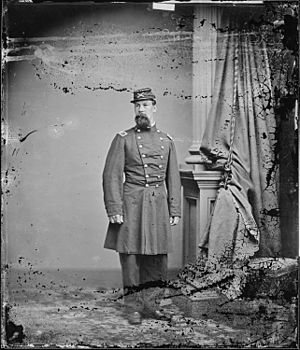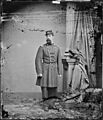William H. Morris facts for kids
Quick facts for kids
William Hopkins Morris
|
|
|---|---|
 |
|
| Born | April 22, 1827 New York City, New York |
| Died | August 26, 1900 (aged 73) Long Branch, New Jersey |
| Allegiance | United States of America |
| Service/ |
United States Army Union Army |
| Years of service | 1851–1854, 1861–1864 |
| Rank | |
William Hopkins Morris (born April 22, 1827, died August 26, 1900) was an American soldier, writer, editor, and inventor. He became a high-ranking officer, a brigadier general, in the Union Army during the American Civil War.
Contents
Becoming a Soldier: Early Life and Training
William Morris was born in New York City on April 22, 1827. His parents were Mary and George Pope Morris.
He joined the United States Military Academy at West Point on July 1, 1846. This is a famous school for training army officers.
Morris worked hard and graduated in 1851. He was 27th in his class of 42 cadets.
After graduating, Morris became a brevet second lieutenant in the 2nd U.S. Infantry Regiment. He first served at a military base in 1851.
In 1852, he was promoted to second lieutenant and served at Fort Yuma, California. He helped recruit new soldiers in 1853. He left the army on February 28, 1854.
Life Outside the Army: Editor and Inventor
After leaving the army in 1854, Morris went back to New York. He helped his father, George, as the Assistant Editor of the New York Home Journal.
Morris also had a talent for inventing. He and Charles L. Brown created an improved firearm. It had a special part that could hold 8 cartridges. They received a patent for this invention in 1860.
Serving in the Civil War
When the American Civil War began, Morris rejoined the army in August 1861. He started as a captain of volunteers.
He worked for Brigadier General John J. Peck. Morris helped Peck during important battles like the Siege of Yorktown, the Battle of Williamsburg, and the Battle of Fair Oaks.
Rising Through the Ranks
On September 1, 1861, Morris left his volunteer position. The very next day, he became a colonel of the 135th New York Volunteer Infantry Regiment. This regiment was later renamed the 6th New York Heavy Artillery Regiment.
Colonel Morris's regiment helped defend Baltimore. On March 16, 1863, Morris was promoted to brigadier general of volunteers. He served in this role from December 1862 to June 1863.
Key Battles and a Serious Injury
During the famous Battle of Gettysburg, Morris's brigade was held in reserve. After this battle, his brigade joined the III Corps of the Army of the Potomac.
Morris's brigade fought in the Battle of Manassas Gap on July 23, 1863. He also took part in the Bristoe Campaign and the Battle of Mine Run in late 1863.
In 1864, Morris fought in the Battle of the Wilderness. During the Battle of Spotsylvania Court House, on May 9, 1864, he was seriously wounded. A sharpshooter shot him in the right knee while he was inspecting his troops.
Morris had to take time off to recover from his wound. He did not return to field service after this injury. From June to August 1864, he served on military courts. He left the army at the end of August 1864 because of his wounds.
While recovering, General Morris wrote a book called Infantry Tactics. It was published in 1865.
Special Recognition
President of the United States Andrew Johnson later honored Morris. He nominated him to be a brevet major general of volunteers. This special honor was confirmed on March 28, 1867.
Life After the War
After the Civil War, William Morris lived on his estate called Briarcliff in Putnam County, New York. He continued to work as an editor for the New York Home Journal.
He also served as a delegate for Putnam County at the Constitutional Convention of the State of New York in 1866. Like his father, he remained active in the New York State Militia. He was the Chief of Ordnance for New York State from 1869 to 1870. He also served as inspector-general from 1873 to 1874.
Morris continued to work on inventions. Even though Charles L. Brown had died, Morris updated their firearm patent. It was reissued in 1871. Morris also published another book in 1879, called "Tactics for Infantry, armed with Breech-loading or Magazine Rifle." He tried to convince the U.S. War Department to use his ideas.
William Hopkins Morris passed away on August 26, 1900. He was on vacation in Long Branch, New Jersey at the time. He is buried in Cold Spring, New York.
Images for kids


